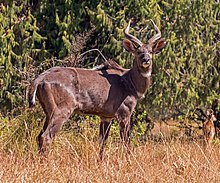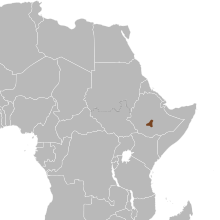Mountain nyala
| Mountain nyala | |
|---|---|

| |
| Male | |

| |
| Female both Bale Mountains National Park, Ethiopia | |
| Scientific classification | |
| Domain: | Eukaryota |
| Kingdom: | Animalia |
| Phylum: | Chordata |
| Class: | Mammalia |
| Order: | Artiodactyla |
| Family: | Bovidae |
| Subfamily: | Bovinae |
| Genus: | Tragelaphus |
| Species: | T. buxtoni
|
| Binomial name | |
| Tragelaphus buxtoni (Lydekker, 1910)
| |


The mountain nyala (
The mountain nyala are shy and elusive towards human beings. Four to five individuals may congregate for short intervals of time to form small herds. Males are not
The typical habitat for the mountain nyala is composed of montane woodlands at an altitude of 3,000–3,400 m (9,800–11,200 ft). Human settlement and large livestock population have forced the animal to occupy heath forests at an altitude of above 3,400 m (11,200 ft). Mountain nyala are endemic to the
Taxonomy
| Phylogenetic relationships of the mountain nyala from combined analysis of all molecular data (Willows-Munro et.al. 2005) |
The mountain nyala was first
In 2005, Sandi Willows-Munro of the
Description
The mountain nyala is a large
The coat is grey to brown, marked with two to five poorly defined white strips extending from the back to the underside, and a row of six to ten white spots. White markings are present on the face, throat and legs as well. The white
Only males possess horns, whose maximum recorded length is 188 cm (74 in). Horns appear as cream-coloured nubs at around six months and start growing in a spiral pattern, reaching full growth by two years.[5] The horns have only one or two spirals, though a few males have been reported to have two-and-a-half turns. The final form might vary in different males – the horns could form well-defined spirals, or could diverge in a structure similar to a lyre, resembling the horns of an impala, but with the final spiral incomplete. Growth rings are visible on the horn sheaths, but the annual patterns might be difficult to comprehend. Though the horns might wear out with age, the cream colour of the tips persists.[5][13]
The mountain nyala resembles the greater kudu in that both have an array of white spots along their flanks and possess spiral horns. However, the greater kudu can be told apart from the mountain nyala due to the former's greater height and paler colour. Moreover, the horns in greater kudu have two to three spirals, and the tips are farther apart. Another species similar to the mountain nyala is the nyala, but the latter can be easily distinguished from the former due to its smaller size and a fringe of long hair along its throat and neck. The horns of nyala, though very similar, are slender and narrower.[12]
Ecology and behaviour

The mountain nyala are shy and elusive towards human beings. They spend the night on the edges of forests, feeding part of the time. To avoid human disturbance, they choose to navigate at night. They come out in morning and late afternoon to browse in grasslands. They generally seek cover in woodlands and heather thickets when it is very hot or cold. Feeding may occur in midday, but is interspersed with resting intervals. They tend to come out when it is overcast or raining. In the dry season (November to March), given the dilapidated state of grasslands, the mountain nyala travel up to the wooden areas rich in ericaceous heath.[14]
Four to five individuals may congregate for short intervals of time to form small herds. However, groups containing as many as 100 individuals have been reported from the
Males are not territorial, and have home ranges covering 15–20 km2 (5.8–7.7 sq mi) in the wet season. Females and juveniles, on the other hand, occupy much smaller ranges of about 5 km2 (1.9 sq mi) in the wet season. Dry season ranges are much larger than the wet season ones for both sexes.[16] Males often wrestle using their horns.[13] Though usually silent, the mountain nyala may "cough" noticing a potential threat, or utter a low bark if the threat is more serious.[3] The leopard is the main predator of the mountain nyala.[13]
Diet
Primarily a browser, the mountain nyala may switch to grazing occasionally. It feeds on low-height herbs, bushes, shrubs and general foliage. They might even eat
Reproduction
Females start mating at two years of age, and males too become
Gestation lasts for eight to nine months, after which a single calf is born. In the Bale Mountains National Park, births occur throughout the year, but peak from September to November. Calves remain in cover for the first few weeks after birth. The calves remain close to their mothers for nearly two years. The young females may get pregnant by then.[3] The young males, as they mature by two years, are challenged by other males and driven out of their herds.[5] The lifespan of a mountain nyala is around 15 to 20 years.[13]
Habitat and distribution

The typical habitat for the mountain nyala is composed of
Nowadays the continuous blocks of woodland habitat have been reduced to a series of pockets, interspersed in large cultivated lands. Human settlement and large livestock population have forced the animal to occupy heath forests at an altitude of above 3,400 m (11,200 ft) rich in Erica arborea, Erica trimera, Hypericum, Euphorbia, and Helichrysum species. They may even be forced into afroalpine grasslands containing Alchemilla and Festuca species, at an altitude of up to 4,300 m (14,100 ft). In the eastern borders of its range, the mountain nyala has usually been observed to occupy areas at lower altitudes of about 1,800–2,400 m (5,900–7,900 ft).[12]
Mountain nyala are endemic to the
Threats and conservation

Major threats to the survival of the mountain nyala include illegal hunting, habitat destruction, encroachment by livestock, predation of calves by dogs, expansion of montane cultivation and construction at high altitudes.[19][20] The animal is extensively hunted for its horns and meat. The meat is utilised in local medicine and for making nipples for traditional milk bottles. Impact of trophy hunting programs is obscure, and current trophy hunting quotas may be unsustainable in the long term although, if well regulated, trophy hunting could play an important role in the long term management of this species.[1][17]
The mountain nyala has been classified under the Endangered category of the
In the 1960s, the population was estimated at 7,000 to 8,000 (and perhaps up to 12,500). This declined sharply to 2,000 to 4,000 individuals in the 1980s. The population is decreasing even now. The mountain nyala is feared to be extinct in the eastern and southern extremes of its range, though a few probably survive in
Relationship with humans
The influence of the mountain nyala, as well as the nyala, on Ethiopian culture can not be ignored. Although nyala is a South African word, several prominent businesses such as Nyala Motors use it in their names. The nyala and mountain nyala often regularly appear on walls, commercial products and tourist curios.[5] The mountain nyala is featured on the obverse of the Ethiopian ten cents coin.[5][24][25]
Mountain nyala are hunted by humans, for instance, by the Oromo people. The Oromo do not hunt these animals in general, except for a day close to Easter, when all able-bodied men set out on horses for a hunt.[5]
References
- ^ a b c d IUCN SSC Antelope Specialist Group (2017) [errata version of 2016 assessment]. "Tragelaphus buxtoni". IUCN Red List of Threatened Species. 2016: e.T22046A115164345.
- OCLC 62265494.
- ^ S2CID 84219997.
- ISBN 978-1-78477-132-4.
- ^ a b c d e f g h i Malcolm, J.; Evangelista, P.H. (2005). "The range and status of the mountain nyala" (PDF): 1–43. Archived from the original (PDF) on 2016-01-28.
{{cite journal}}: Cite journal requires|journal=(help) - .
- ^ Evangelista, P.; Waltermire, R.; Swartzinski, P. (2007). "A profile of the mountain nyala (Tragelaphus buxtoni)". African Indaba: 1–47.
- PMID 15878131.
- ISBN 978-1-4214-0093-8.
- ^ Ropiquet, A. (2006). "Etude des radiations adaptatives au sein des Antilopinae (Mammalia, Bovidae)". Ph.D. Thesis, Université Paris. 6 (1–247).
- PMID 22226162.
- ^ ISBN 978-1-4081-2257-0.
- ^ a b c d e Aleman, M. "Tragelaphus buxtoni Mountain nyala". Animal Diversity Web. University of Michigan Museum of Zoology. Retrieved 21 January 2016.
- ^ .
- ^ Hillman, J.C.; Hillman, S.M. (1987). "The mountain nyala Tragelaphus buxtoni and the Simien fox Canis simensis in the Bale Mountains National Park". Walia. 10: 3–6.
- ^ .
- ^ ISBN 978-2-8317-0477-7.
- doi:10.1071/WR07173.
- ^ Mamo, Y.; Bekele, A. (2011). "Human and livestock encroachments into the habitat of Mountain Nyala (Tragelaphus buxtoni) in the Bale Mountains National Park, Ethiopia". Tropical Ecology. 52 (3): 265–73.
- PMID 21943288.
- ^ Woldegebriel, G.K. (1996). "The status of mountain nyala (Tragelaphus buxtoni) in Bale Mountains National Park 1986–1994". Walia. 17: 27–37.
- .
- .
- ISBN 978-1-4402-4410-0.
- ^ Balletto, B.L. (1995). Spectrum guide to Ethiopia. Camerapix Publishers. p. 295.
External links
(Mountain nyala).
- ITIS entryon Tragelaphus buxtoni

